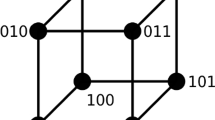Abstract
A function \(f: 2^V \rightarrow \mathbb {R}\) on a finite set V is posimodular if \(f(X)+f(Y) \ge f(X{\setminus } Y)+f(Y{\setminus } X)\), for all \(X,Y\subseteq V\). Posimodular functions often arise in combinatorial optimization such as undirected cut functions. We consider the problem of finding a nonempty subset X minimizing f(X), when the posimodular function f is given by oracle access. We show that posimodular function minimization requires exponential time, contrasting with the polynomial solvability of submodular function minimization that forms another generalization of cut functions. On the other hand, the problem is fixed-parameter tractable in terms of the size D of the image (or range) of f. In more detail, we show that \(\varOmega (2^{0.32n} T_f)\) time is necessary and \(O(2^{0.92n}T_f)\) sufficient, where \(T_f\) denotes the time for one function evaluation and \(n = |V|\). When the image of f is \(D=\{0,1,\ldots ,d\}\) for integer d, \(O(2^{1.218d}nT_f)\) time is sufficient. We can also generate all sets minimizing f in time \(2^{O(d)} n^2 T_f\). Finally, we also consider the problem of maximizing a given posimodular function, showing that it requires at least \(2^{n-1}T_f\) time in general, while it has time complexity \(\varTheta ({n \atopwithdelims ()d-1}T_f)\) when \(D=\{0,1,\ldots , d\}\) is the image of f, for integer \(d=O(n^{1/4})\).

Similar content being viewed by others
References
Arata, K., Iwata, S., Makino, K., Fujishige, S.: Locating sources to meet flow demands in undirected networks. J. Algorithms 42, 54–68 (2002)
Chekuri, C., Ene, A.: Approximation algorithms for submodular multiway partition. In: IEEE 52nd Annual Symposium on Foundations of Computer Science, pp. 807–816 (2011)
Egres open problem list: http://lemon.cs.elte.hu/egres/open/Maximizing_a_skew-supermodular_function
Feige, U., Mirrokni, V.S., Vondrák, J.: Maximizing non-monotone submodular functions. SIAM J. Comput. 40, 1133–1153 (2011)
Frank, A.: Augmenting graphs to meet edge-connectivity requirements. SIAM J. Discrete Math. 5(1), 25–53 (1992)
Fujishige, S.: A laminarity property of the polyhedron described by a weakly posi-modular set function. Discrete Appl. Math. 100(1–2), 123–126 (2000)
Halldórsson, M.M., Ishii, T., Makino, K., Takazawa, K.: Posimodular function optimization. In: Proceedings of 15th International Symposium on Algorithms and Data Structures (WADS), pp. 437–448. Springer (2017)
Ishii, T., Makino, K.: Posi-modular systems with modulotone requirements under permutation constraints. Discrete Math. Algorithms Appl. 2(1), 61–76 (2010)
Ito, H., Makino, K., Arata, K., Honami, S., Itatsu, Y., Fujishige, S.: Source location problem with flow requirements in directed networks. Optim. Methods Softw. 18, 427–435 (2003)
Lawler, E.L.: Cutsets and partitions of hypergraphs. Networks 3(3), 275–285 (1973)
Lee, Y.T., Sidford, A., Wong, S.C.: A faster cutting plane method and its implications for combinatorial and convex optimization. In: IEEE 56th Annual Symposium on Foundations of Computer Science (FOCS), pp. 1049–1065. IEEE Computer Society (2015)
Lokshtanov, D., Marx, D.: Clustering with local restrictions. Inf. Comput. 222, 278–292 (2013)
Nagamochi, H.: Graph algorithms for network connectivity problems. J. Oper. Res. Soc. Japan 47(4), 199–223 (2004)
Nagamochi, H.: Minimum degree orderings. Algorithmica 56(1), 17–34 (2010)
Nagamochi, H., Ibaraki, T.: A note on minimizing submodular functions. Inf. Process. Lett. 67(5), 239–244 (1998)
Nagamochi, H., Ibaraki, T.: Polyhedral structure of submodular and posi-modular systems. Discrete Appl. Math. 107(1–3), 165–189 (2000)
Nagamochi, H., Shiraki, T., Ibaraki, T.: Augmenting a submodular and posi-modular set function by a multigraph. J. Combin. Optim. 5(2), 175–212 (2001)
Sakashita, M., Makino, K., Nagamochi, H., Fujishige, S.: Minimum transversals in posi-modular systems. SIAM J. Discrete Math. 23, 858–871 (2009)
Svitkina, Z., Tardos, É.: Min–max multiway cut. In: Approximation, Randomization, and Combinatorial Optimization, pp. 207–218 (2004)
Tamura, H., Sugawara, H., Sengoku, M., Shinoda, S.: Plural cover problem on undirected flow networks. IEICE Trans. J81–A, 863–869 (1998). ((in Japanese))
van den Heuvel, J., Johnson, M.: The external network problem with edge- or arc-connectivity requirements. In: Combinatorial and Algorithmic Aspects of Networking, Lecture Notes in Computer Science, vol. 3405, pp. 114–126. Springer (2004)
Watanabe, T., Nakamura, A.: Edge-connectivity augmentation problems. J. Comput. Syst. Sci. 35, 96–144 (1987)
Acknowledgements
We are most grateful for suggestions from anonymous reviewers that allowed us to improve the time complexity of Algorithm 3 and simplify several arguments. We thank S. Fujishige, M. Grötschel, and S. Tanigawa for their helpful comments. This research was partially supported by the Scientific Grant-in-Aid from Ministry of Education, Culture, Sports, Science and Technology of Japan.
Author information
Authors and Affiliations
Corresponding author
Additional information
Publisher's Note
Springer Nature remains neutral with regard to jurisdictional claims in published maps and institutional affiliations.
An extended abstract of this article was presented in Proceedings of the 15th International Symposium on Algorithms and Data Structures (WADS 2017) [7]
This research was partially supported by Icelandic Research Fund Grants 152679-05 and 174484-05, MEXT KAKENHI Grant Numbers JP24106002, JSPS KAKENHI Grant Numbers JP25280004, JP26280001, JP16K00001 and 20K11699, and JST CREST Grant Number JPMJCR1402, Japan.
Rights and permissions
About this article
Cite this article
Halldórsson, M.M., Ishii, T., Makino, K. et al. Posimodular Function Optimization. Algorithmica 84, 1107–1131 (2022). https://doi.org/10.1007/s00453-021-00910-y
Received:
Accepted:
Published:
Issue Date:
DOI: https://doi.org/10.1007/s00453-021-00910-y




